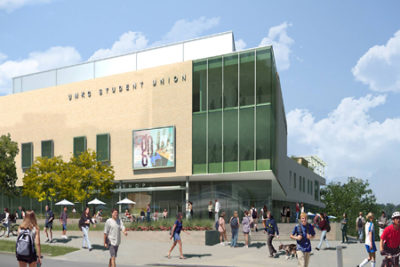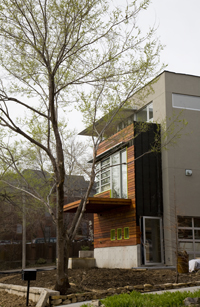UMKC shows how economy and environment can work together
Although a recent Gallup poll shows that most people would sacrifice sustainability for economic growth, the University of Missouri-Kansas City is showing how the environment and economy benefit from each other.
Green Campus Conversion
According to the UMKC Sustainability Team — which includes more than 80 students, staff, faculty and community members — UMKC has saved at least 6,596 trees, 384 tons of air pollution and 2.7 million gallons of water. Campus sustainability efforts include:
- UMKC’s Clean Commute program — which provides free bicycles to students, staff and faculty — has helped people save money while reducing on pollution.
- The LEED-certified New Student Union — which is slated to open in the fall of 2010 — will reduce electricity costs by utilizing natural light with an atrium.
- UMKC’s chilled water plant replacement — which controls chilled water, electric and plumbing systems — is projected to save UMKC about $1.6 million each year while reducing emissions by 30 percent.
- By eliminating biodegradable plastic trays in August of 2008, UMKC Dining Services has saved hundreds of gallons of water each day and significant amounts of heating energy.
Green Classrooms and Green Jobs
In the College of Arts and Sciences’ Department of Economics, professors aren’t just focusing on green cash. They’re focusing on how the environment and economy work together.
The department’s Environment, Resources and Economic Growth course, for example, explores the role economic theory plays in environmental policy and how environmental, ecological and evolutionary studies can add to peoples’ understanding of economic processes.
“The ongoing ‘jobs versus the environment’ mindset needs to be replaced with a ‘jobs and the environment’ attitude,” said Mathew Forstater, associate professor of economics and black studies, who has published several studies on green jobs. “There is now significant evidence that environmental regulation does not result in loss of jobs and that protecting the environment has actually generated employment.”
Forstater has proposed a Green Job Corps program, which would offer a public service employment (PSE) job to anyone ready and willing to work for a basic PSE wage-benefits package.
 Such environmental (and economic) progress requires sustainable planning, and design is the answer to several environmental problems, said Joy Swallow, chair of the College of Arts and Sciences’ Department of Architecture, Urban Planning and Design (AUPD) and associate professor. Through real-world projects and environmentally-focused courses, the AUPD program teaches students how to solve problems and modify the systems people live in.
Such environmental (and economic) progress requires sustainable planning, and design is the answer to several environmental problems, said Joy Swallow, chair of the College of Arts and Sciences’ Department of Architecture, Urban Planning and Design (AUPD) and associate professor. Through real-world projects and environmentally-focused courses, the AUPD program teaches students how to solve problems and modify the systems people live in.
Urban planning and design students have worked with Kansas City’s Washington Wheatley Neighborhood to develop an Action Plan that will guide the area’s transformation to a 21st Century Green Neighborhood. The plan calls for stabilizing, preserving, and rebuilding a sustainable urban model.
Toward the end of the fall 2008 semester, Lauren Wendlandt — AUPD research assistant and architect — invited students to tour the construction of her urban, environmentally-friendly, live/work home as an example of sustainable design. The two-story building features reused barn siding, solar power, skylights, a white rubber roof, LED lightbulbs, tankless water heaters and an 1,800-gallon underground system to collect rainwater from the roof.
Although the environmentally-friendly project involved more upfront costs than a typical project would, Wendlandt said it will save them more money in the long-run. The LED lightbulbs cost $22 per bulb, but Wendlandt estimates that it will eventually reduce their utilities costs by about $23,000. In addition, Wendlandt said the government will pay for a third of the solar power on the roof.
To save on upfront costs and to understand the project better, Wendlandt and her husband built the home after a general contractor installed the rough-end framing, plumbing and electricity. They saved money by building with recycled materials, and they helped the regional economy and the environment by not using materials from more than 500 miles away. The couple will make a profit by renting a portion of the building to an outside business, as well.
“People need to take a lifecycle cost perspective,” Swallow said. “The majority of sustainability doesn’t cost more. It’s really about being aware of site and context — taking advantage of natural daylight, natural ventilation, trees for shade and heat from the sun. These basic ideas are incorporated into our studio projects as integral components to consider in the overall design.”


